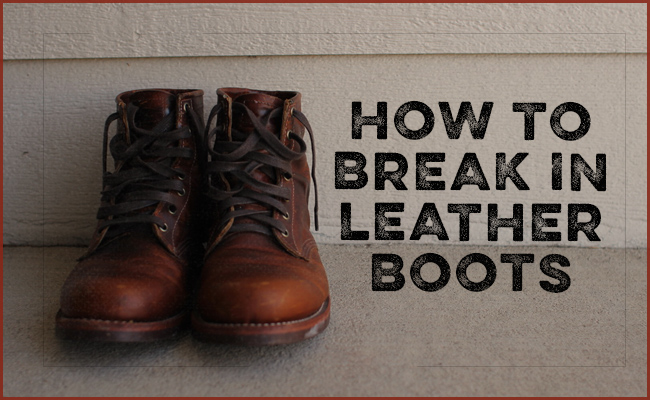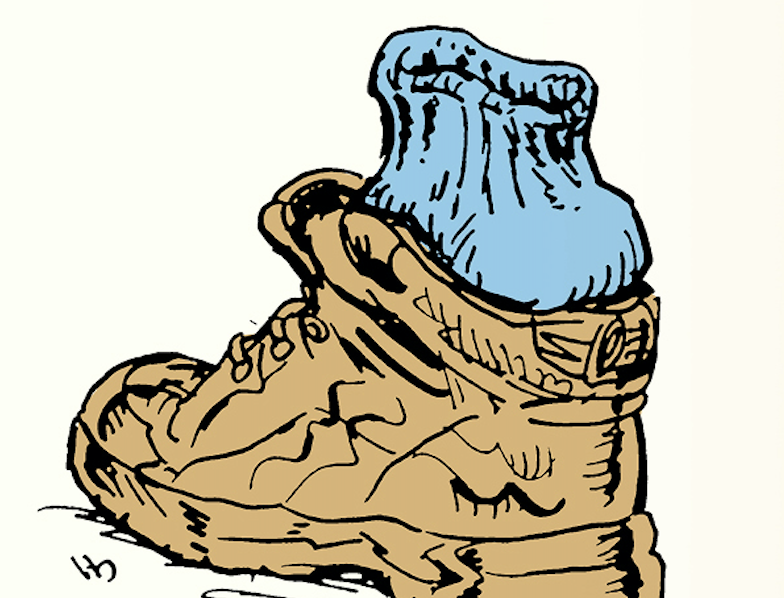A good pair of leather boots is an essential part of every man’s wardrobe, particularly in the fall and winter. Say you got a nice shiny pair of Red Wing boots for Christmas or your birthday, or you just wanted to splurge with your end-of-year bonus. You’re excited to lace ‘em up and wear your boots to work or out on a date, but they’re stiff and a little hard to put on, and when you walk around, they feel a little uncomfortable after a while.
That’s just part of the reality of owning a pair of boots made from leather: it’s a hard, tough material (which is why it’s so dang durable!). Leather boots thus need to be broken in before they’re comfortable for regular and prolonged use.
How do you do that though? The tried and true method is to just wear them and deal with the discomfort — sometimes including blisters — until the leather becomes softer and more comfortable. We live in the internet age though. Aren’t there any hacks or tricks to breaking them in a little quicker and without as much discomfort?
The short answer: nope. There are a few things you can do to ease the discomfort, but in general, any hacks or quick tips you see out there pose too much of a risk to the leather to be worth trying. When you’re spending $200 or more on your shoes (which is about as cheap as you can get a high-quality pair of boots), you don’t want them wrecked before you’ve gotten a chance to enjoy them for a few decades.
Below you’ll find out why some of the tricks you see online shouldn’t be utilized, as well as a few tips for easing the discomfort of the breaking-in process.
Dispelling Some Internet Tricks
In doing some initial internet research, I was presented with almost exactly what I expected to find: a few apparently quick and painless hacks that would instantly break in a pair of leather boots.
Most of what I found revolved around subjecting the leather to extremes in terms of water and heat. Leather is obviously an incredibly resistant material, so while prolonged exposure to these elements isn’t good for it, an initial blast to soften things up won’t hurt. Right? That’s how the thinking goes at least.
Thankfully, I didn’t trust the internet, and called up a local Red Wing shoe store to get the dope on these shortcuts rather than trying them out firsthand and possibly ruining a nice pair of boots.
Water Exposure
I saw tips out there ranging from submerging the boots in a tub full of water, to wearing wet socks in an attempt to get the leather to mold more to your feet.
The logic of this line of reasoning isn’t all that crazy. Water immersion does make leather more pliable, and in fact many leather projects rely on the material being soaked for the sake of molding it into some shape (like a knife sheath). Leather boots have a blue collar heritage, that typically isn’t just a matter of aesthetics: you generally should be able to wear them in wet and messy conditions, and have them hold up just fine. Thus manufacturers themselves sometimes used to in fact recommend breaking in their boots with the water exposure method.
It’s hard to find any that do anymore, though. The problem is that water immersion can actually shrink your boots, doing the opposite of what you intended.
Plus, while not a guarantee, it’s sure a possibility that the water could warp or otherwise damage not only the leather, but the soles as well, especially in more modern-style boots that have a cushioned insole vs. just a hard leather one. While your boots should be fine when worn out on a rainy day, that’s not quite the same as giving them a prolonged soaking in a bucket of water.
Bottom line: Avoid this route.
Direct Heat Exposure
The other primary line of thinking I saw in terms of break-in hacks was heat exposure. Again, from a purely logical perspective, this idea isn’t too bad. Heat also makes leather more pliable, so putting a hair dryer on them or putting them next to a fire should help, right?
It can, but the risks to your leather aren’t worth it. Prolonged or extreme heat exposure will dry the leather and make it crack. It can also warp the material and change the leather’s color. While you’ll find plenty of sources out there that say a hair dryer on low heat is okay, the vast majority of manufacturers recommend avoiding exposure to any direct heat source like that.
The primary problem with heat is that you just don’t know how your particular leather boot will react to it, or at what point the heat becomes too much and starts causing damage (which isn’t always apparent; fibers can start to dry and crack before it’s visible to the eye).
Avoid this route too.
Tips for Breaking In Your Boots the Right Way
Keep in mind at the outset that every brand of leather boot wears and breaks in differently. My Chippewa boots are still getting broken in a few years later, but my Nisolo Andres — my new favorites — wore just about perfectly right out the box. Some discomfort at first is expected (especially if you try to wear them all day), but definitely not pain.
1. First, ensure the right size. Sometimes you’ll see folks advocating buying boots a half-size or even full size too small so that when they break in, they’ll be perfect. In some cases this can be accurate (like with Chippewas), but not all. I advocate for always buying your leather boots from the manufacturer directly, either online or in retail. Going to a big box store and asking about how their boots are sized isn’t going to work very well. The manufacturer, on the other hand, will have the most accurate sizing information and be able to guide you. It all depends on how the leathers they use have been made and treated.
In general, it’s okay if the boot seems a little narrow — leather can expand out to the sides fairly easily. On the other hand, you don’t ever want to buy a boot that’s too short. The toe box and heel are the thickest, most rigid parts of the shoe and aren’t going to move much.
2. Use a leather conditioner/oil. Right when you get your boots, apply some leather conditioner (I like Chamberlain’s Leather Milk) or mink oil. These will help soften the leather, and won’t cause the damage that heat or water will. Apply weekly until the shoes are broken in, and then monthly or so after that as part of your leather care routine.
3. Ease into it. Wear them around the house, in thick socks, for 1-2 weeks. While it’s true that simply wearing your shoes is the best way to break them in, it doesn’t have to be such a painful process. Before wearing them all day at work or heading out on the town as a method of brute force adaption, wear them around the house with a pair of thick socks. You want it to feel tight and even a touch uncomfortable (in terms of tightness, not pain). Wear two pairs if needed.
There are a few benefits to employing this method.
First, when you wear your boots around the house you tend to be up and down a lot, giving your feet a rest between use rather than standing or walking around at a constant clip for an extended period of time.
Second, when you wear a thick pair or two of socks, you end up stretching the leather just a bit. Producing this kind of gradual pressure is preferred, as that’s healthiest for the material. At the same time, you’re generating some heat from the friction and warmth of the heavy socks, which will help mold the leather — again, very gradually, which is ideal.
Finally, by first wearing your boots with the padding of thick socks, you reduce the number of blisters and hot spots you’ll get. If you do still get some, give the areas of irritation extra protection with a band-aid.
4. Use a shoe/boot stretcher. If after 80-100 hours of wear your boots aren’t comfortable for an 8-hour day, you may need to take one final step, moving beyond breaking in your boots with your own fleshy feet, to re-shaping things a bit with external stretchers.
A couple years ago, I bought my wife some Red Wing boots for Christmas. They were definitely the right size, and mostly comfortable, but after about a half day of wear, they’d start to feel a little tight and a little blistery just at the widest part of her feet. A small thing, really, but something that would perhaps keep her from wearing them as much as she wanted.
I looked into taking them to the Red Wing store to see what they could do, but I dug into some boot forums (yes, they exist!) and found that shoe stretchers — the kind you can just buy on Amazon — have generally rave reviews when it comes to small adjustments that are needed with your leather boots.
Shoe stretchers look basically like shoe trees, but instead of being solid, they have a mechanism that expands the tree while inside the shoe so that it gently and gradually stretches the material.
I bought a pair of stretchers for those Red Wings, and after just a few days they were perfectly adjusted (and have stayed that way). My wife went from being a little sore in them after a half day or so, to comfortably walking all around San Francisco on a vacation over the course of 3 very full days. I was pretty amazed actually.
There isn’t much to using them: simply insert into the shoe, twist the knob that widens the toe sections — just enough to feel some resistance and hear the leather creaking just a bit, and let it go to work. You don’t want to stretch them out too much all at once. Again, set it so there’s some resistance, and then give it a little more over successive nights until it’s just right. As an extra precaution, moisturize the boot while doing this with either conditioner or oil. It will both soften the leather for stretching and proactively protect against any cracking.
Some things in life just aren’t hackable. Breaking in your leather boots is one of those things. Once you’ve done it though, they’ll be set for everyday use and decades of wear.








